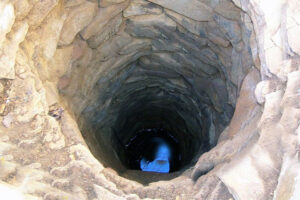 When there are so many different options about how to install your well, how do you know what to go with? Here is a guide to help you understand the differences in dug, point, or driven artesian wells.
When there are so many different options about how to install your well, how do you know what to go with? Here is a guide to help you understand the differences in dug, point, or driven artesian wells.
Dug Wells
One way to go about installing your well is by going at the ground with a pick and shovel. If the ground is soft and the water table is pretty shallow, then this is a viable option for you. In the past dug wells were all created by hand and workers would shovel down below the water table until the incoming water would exceed the digger’s bailing rate. The well would then be lines with tile, bricks or stones in order to prevent collapse. It was covered up with wood, stone or concrete. However you can’t dig a hole much further than the water table, or water would just keep filling the hole you created.
Driven Wells
This option is still pretty common. Driven wells are created by driving a small pipe into either sand or gravel. A screen is attached to the bottom in order to filter out any debris. The only issue with this method is that it can only access shallow water. This can be an issue due to the contaminants and pollutants that are at the surface.
Drilled Wells
Most of the modern wells that exist today are drilled. This tends to require a large and pricey drill rig. Usually they can be found mounted on big trucks. These drills have drill bits that can go through rock, along with percussion bits that can smash the rocks, or if the ground is soft then they can go through those as well. Wells that are drilled can be up to 1,000 feet deep. A pump is usually installed as well so that water can be pushed up toward the surface.
At Northeast Water Wells, we specialize in drilled wells because they offer the best consistency. The other two types of wells might work, but they run a higher chance of running dry or having harmful contaminants. If you still have questions about the differences in wells, feel free to contact us today!

Recent Comments